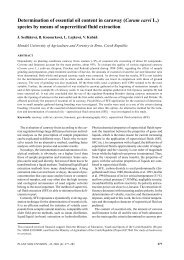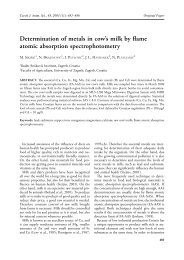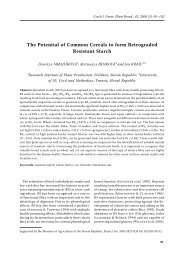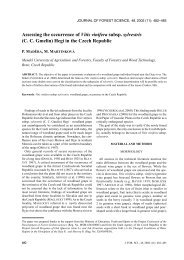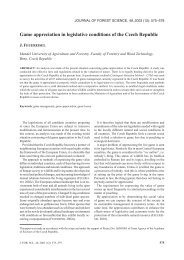Effect of active ventilation on baking quality of wheat by long-term ...
Effect of active ventilation on baking quality of wheat by long-term ...
Effect of active ventilation on baking quality of wheat by long-term ...
You also want an ePaper? Increase the reach of your titles
YUMPU automatically turns print PDFs into web optimized ePapers that Google loves.
<str<strong>on</strong>g>Effect</str<strong>on</strong>g> <str<strong>on</strong>g>of</str<strong>on</strong>g> <str<strong>on</strong>g>active</str<strong>on</strong>g> <str<strong>on</strong>g>ventilati<strong>on</strong></str<strong>on</strong>g> <strong>on</strong> <strong>baking</strong> <strong>quality</strong> <str<strong>on</strong>g>of</str<strong>on</strong>g> <strong>wheat</strong><br />
<strong>by</strong> l<strong>on</strong>g-<strong>term</strong> storage<br />
L. SYCHRA, L. HŘIVNA, J. MAREČEK<br />
Mendel University <str<strong>on</strong>g>of</str<strong>on</strong>g> Agriculture and Forestry, Brno, Czech Republic<br />
ABSTRACT: Supplies <str<strong>on</strong>g>of</str<strong>on</strong>g> even-<strong>quality</strong> food <strong>wheat</strong> can be ensured <strong>by</strong> using l<strong>on</strong>g-<strong>term</strong> (several years) storage with a possibility<br />
<str<strong>on</strong>g>of</str<strong>on</strong>g> <str<strong>on</strong>g>active</str<strong>on</strong>g> <str<strong>on</strong>g>ventilati<strong>on</strong></str<strong>on</strong>g>. The authors studied qualitative changes <str<strong>on</strong>g>of</str<strong>on</strong>g> <strong>baking</strong> properties in food <strong>wheat</strong> varieties for the period <str<strong>on</strong>g>of</str<strong>on</strong>g><br />
742 (530) days <str<strong>on</strong>g>of</str<strong>on</strong>g> storage. The <strong>quality</strong> parameters were currently measured in order to make final assessments <str<strong>on</strong>g>of</str<strong>on</strong>g> effects <str<strong>on</strong>g>of</str<strong>on</strong>g><br />
variety, storage time and harvest year. An important parameter for <strong>baking</strong> qualities is the value <str<strong>on</strong>g>of</str<strong>on</strong>g> falling number. The studied<br />
varieties exhibited its increase with the excepti<strong>on</strong> <str<strong>on</strong>g>of</str<strong>on</strong>g> the variety Hana which showed a declining trend in dependence <strong>on</strong> the<br />
time <str<strong>on</strong>g>of</str<strong>on</strong>g> storage. The varieties Asta, Brea, Bruta, Hana and Samara had average values <str<strong>on</strong>g>of</str<strong>on</strong>g> falling number 320.85 sec (346.00 sec<br />
at the end <str<strong>on</strong>g>of</str<strong>on</strong>g> measurements), 293.50 sec (255.00 sec at the end <str<strong>on</strong>g>of</str<strong>on</strong>g> measurements), 284.88 sec (357.00 sec at the end), 332.85 sec<br />
(310.00 sec at the end) and 232.86 sec (243.00 sec at the end), respectively.<br />
Keywords: viscotest; sedimentati<strong>on</strong> test; gluten c<strong>on</strong>tent; protein c<strong>on</strong>tent; gluten index<br />
The provisi<strong>on</strong> <str<strong>on</strong>g>of</str<strong>on</strong>g> even-<strong>quality</strong> food <strong>wheat</strong> supplies<br />
for year-l<strong>on</strong>g storage until the next harvest still appears<br />
to be a problem. Similarly, possible differences<br />
in the technological <strong>quality</strong> <str<strong>on</strong>g>of</str<strong>on</strong>g> <strong>wheat</strong> grain between individual<br />
years unfavourably reflect in the <strong>quality</strong> <str<strong>on</strong>g>of</str<strong>on</strong>g><br />
manufactured products, especially in years with<br />
unfavourable climatic c<strong>on</strong>diti<strong>on</strong>s at the time <str<strong>on</strong>g>of</str<strong>on</strong>g> maturati<strong>on</strong><br />
and harvest. Wheat breeders have to face problems<br />
in achieving the required <strong>quality</strong>, which reflects<br />
in realizati<strong>on</strong> costs. Another problem is to keep the<br />
<strong>quality</strong> during the processes <str<strong>on</strong>g>of</str<strong>on</strong>g> handling and storage<br />
until the moment <str<strong>on</strong>g>of</str<strong>on</strong>g> processing.<br />
A possibility <str<strong>on</strong>g>of</str<strong>on</strong>g> ensuring the individual supplies <str<strong>on</strong>g>of</str<strong>on</strong>g><br />
even-<strong>quality</strong> food <strong>wheat</strong> for processing appears to be<br />
the use <str<strong>on</strong>g>of</str<strong>on</strong>g> l<strong>on</strong>g-<strong>term</strong> (several years) storage <str<strong>on</strong>g>of</str<strong>on</strong>g> qualitative<br />
batches <str<strong>on</strong>g>of</str<strong>on</strong>g> food <strong>wheat</strong>.<br />
The issue is being solved at the Mendel University <str<strong>on</strong>g>of</str<strong>on</strong>g><br />
Agriculture and Forestry in Brno in cooperati<strong>on</strong> with<br />
the Agricultural Research Institute in Kroměříž.<br />
Achieved results suggest usefulness <str<strong>on</strong>g>of</str<strong>on</strong>g> the chosen approach<br />
to the problem soluti<strong>on</strong>.<br />
Regarding the hitherto results <str<strong>on</strong>g>of</str<strong>on</strong>g> the authors’ research<br />
into the possibilities <str<strong>on</strong>g>of</str<strong>on</strong>g> using c<strong>on</strong>trolled <str<strong>on</strong>g>ventilati<strong>on</strong></str<strong>on</strong>g><br />
at the storage <str<strong>on</strong>g>of</str<strong>on</strong>g> cereals, and with respect to the<br />
results <str<strong>on</strong>g>of</str<strong>on</strong>g> analyses studying the influence <str<strong>on</strong>g>of</str<strong>on</strong>g> storage<br />
methods <strong>on</strong> the <strong>quality</strong> <str<strong>on</strong>g>of</str<strong>on</strong>g> cereals for food products<br />
(SYCHRA, HUBÍK 1998), it was chosen to study selected,<br />
in <strong>term</strong>s <str<strong>on</strong>g>of</str<strong>on</strong>g> <strong>baking</strong> crucial parameters during<br />
the storage with a system <str<strong>on</strong>g>of</str<strong>on</strong>g> <str<strong>on</strong>g>active</str<strong>on</strong>g> <str<strong>on</strong>g>ventilati<strong>on</strong></str<strong>on</strong>g>. It can<br />
be assumed in c<strong>on</strong>nexi<strong>on</strong> with previously found results<br />
(MAREČEK, SYCHRA 1999; MAREČEK et al. 2001) also<br />
for other crops (malting barley) that a maintenance <str<strong>on</strong>g>of</str<strong>on</strong>g><br />
identical good or just slightly impaired <strong>quality</strong> <str<strong>on</strong>g>of</str<strong>on</strong>g> food<br />
<strong>wheat</strong> grain over the l<strong>on</strong>g-<strong>term</strong> storage can be ensured<br />
under observance <str<strong>on</strong>g>of</str<strong>on</strong>g> optimum c<strong>on</strong>diti<strong>on</strong>s <str<strong>on</strong>g>of</str<strong>on</strong>g> the storage.<br />
An important role at storing food <strong>wheat</strong> grain is<br />
played <strong>by</strong> temperature, which affects biochemical characteristics<br />
<str<strong>on</strong>g>of</str<strong>on</strong>g> grain. As menti<strong>on</strong>ed <strong>by</strong> REHMAN and<br />
SHAH (1999), higher temperatures <str<strong>on</strong>g>of</str<strong>on</strong>g> storage result in<br />
the decreasing pH value and increasing titrable acidity,<br />
especially at temperatures above 25°C. The higher<br />
temperatures also bring about the decreasing water<br />
c<strong>on</strong>tent in the grain, particularly so when the grain<br />
was put into the store with higher initial moisture c<strong>on</strong>tent.<br />
In c<strong>on</strong>trast, no significant biochemical changes <str<strong>on</strong>g>of</str<strong>on</strong>g><br />
the grain were found at the lower storage temperature<br />
<str<strong>on</strong>g>of</str<strong>on</strong>g> 10°C.<br />
The temperature used for storage also affects the producti<strong>on</strong><br />
<str<strong>on</strong>g>of</str<strong>on</strong>g> respiratory microbial heat – as menti<strong>on</strong>ed<br />
for example <strong>by</strong> COFIE-AGBLOR et al. (1997). Heat generati<strong>on</strong><br />
in the layer <str<strong>on</strong>g>of</str<strong>on</strong>g> grain at storage is induced <strong>by</strong><br />
aerobic and anaerobic respirati<strong>on</strong> with the aerobic respirati<strong>on</strong><br />
forming 91–97% <str<strong>on</strong>g>of</str<strong>on</strong>g> total heat. Heat producti<strong>on</strong><br />
is higher at using higher temperatures, particularly<br />
for storage temperatures above 20°C combined with<br />
a higher moisture c<strong>on</strong>tent. With storage temperatures<br />
being at the level <str<strong>on</strong>g>of</str<strong>on</strong>g> 10°C it has been evidenced that the<br />
heat producti<strong>on</strong> remains at a c<strong>on</strong>stant level for the<br />
whole time <str<strong>on</strong>g>of</str<strong>on</strong>g> the storage.<br />
The above presented results and c<strong>on</strong>clusi<strong>on</strong>s were achieved within the soluti<strong>on</strong> <str<strong>on</strong>g>of</str<strong>on</strong>g> the Grant MSM No. 432100001 funded <strong>by</strong> the<br />
Ministry <str<strong>on</strong>g>of</str<strong>on</strong>g> Educati<strong>on</strong>, Youth and Sports <str<strong>on</strong>g>of</str<strong>on</strong>g> the Czech Republic.<br />
RES. AGR. ENG., 48, 2002 (1): 17–22<br />
23
MATERIAL AND METHODS<br />
Grain samples used for l<strong>on</strong>g-<strong>term</strong> storage were those <str<strong>on</strong>g>of</str<strong>on</strong>g><br />
varieties Asta, Brea, Bruta, Hana and Samara from the<br />
harvest years 1997 and 1998. The <strong>wheat</strong> grain from the<br />
harvest in 1997 was stored for a total <str<strong>on</strong>g>of</str<strong>on</strong>g> 742 days and the<br />
samples from the harvest in 1998 were stored for<br />
530 days. The grain <str<strong>on</strong>g>of</str<strong>on</strong>g> all varieties was put into bags<br />
made <str<strong>on</strong>g>of</str<strong>on</strong>g> air-permeable plastic n<strong>on</strong>-woven textile material.<br />
The bags filled with the samples <str<strong>on</strong>g>of</str<strong>on</strong>g> 1 kg each were placed<br />
into the layer <str<strong>on</strong>g>of</str<strong>on</strong>g> grain in the silo at a depth <str<strong>on</strong>g>of</str<strong>on</strong>g> 0.5 m below<br />
the surface <str<strong>on</strong>g>of</str<strong>on</strong>g> the stored grain. The used storage chamber<br />
had a possibility <str<strong>on</strong>g>of</str<strong>on</strong>g> <str<strong>on</strong>g>active</str<strong>on</strong>g> <str<strong>on</strong>g>ventilati<strong>on</strong></str<strong>on</strong>g> during the storage.<br />
The storage chamber capacity was 750 t<strong>on</strong>s. The air<br />
volume supplied <strong>by</strong> ventilators was 0.23 m 3 /sec. In the<br />
first 11 m<strong>on</strong>ths <str<strong>on</strong>g>of</str<strong>on</strong>g> the study the system <str<strong>on</strong>g>of</str<strong>on</strong>g> <str<strong>on</strong>g>active</str<strong>on</strong>g><br />
<str<strong>on</strong>g>ventilati<strong>on</strong></str<strong>on</strong>g> was operated at all times from 18.00 to<br />
06.00 o’clock (air volume exchange was 6,652.8 m 3 for<br />
each chamber). In the following period, the <str<strong>on</strong>g>ventilati<strong>on</strong></str<strong>on</strong>g><br />
was <strong>on</strong> for <strong>on</strong>ly two hours a day (air volume exchange<br />
being 1,663.2 m 3 ). In the last period <str<strong>on</strong>g>of</str<strong>on</strong>g> storage, the<br />
system <str<strong>on</strong>g>of</str<strong>on</strong>g> <str<strong>on</strong>g>active</str<strong>on</strong>g> <str<strong>on</strong>g>ventilati<strong>on</strong></str<strong>on</strong>g> was employed for 6 hours<br />
<strong>on</strong>ce in 14 days.<br />
The temperature inside the grain layer ranged from<br />
5 to 17°C during the experiment and the relative moisture<br />
c<strong>on</strong>tent <str<strong>on</strong>g>of</str<strong>on</strong>g> grain was ranging from 13 to 14.5%<br />
with the value <str<strong>on</strong>g>of</str<strong>on</strong>g> 14.5% representing the initial moisture<br />
<str<strong>on</strong>g>of</str<strong>on</strong>g> introduced grain.<br />
The <strong>wheat</strong> grain samples were gradually taken out<br />
from the bags and measured for following <strong>baking</strong> <strong>quality</strong><br />
traits: falling number, sedimentati<strong>on</strong> test, protein<br />
c<strong>on</strong>tent, gluten c<strong>on</strong>tent and gluten index. All analyses<br />
were carried out to the ICC standards (ANONYMOUS<br />
1996) and AACC (ANONYMOUS 1995).<br />
Significance <str<strong>on</strong>g>of</str<strong>on</strong>g> the effect <str<strong>on</strong>g>of</str<strong>on</strong>g> storage time, variety and<br />
harvest year <strong>on</strong> the studied parameters was evaluated<br />
<strong>by</strong> the analysis <str<strong>on</strong>g>of</str<strong>on</strong>g> variance and the measure <str<strong>on</strong>g>of</str<strong>on</strong>g> the effect<br />
<str<strong>on</strong>g>of</str<strong>on</strong>g> the given factors de<strong>term</strong>ined.<br />
RESULTS AND DISCUSSION<br />
Results from <strong>quality</strong> analyses were used to make an<br />
aggregative table (Table 1) with basic values characterizing<br />
the given <strong>quality</strong> trait average at the beginning<br />
<str<strong>on</strong>g>of</str<strong>on</strong>g> the experiment and at the end <str<strong>on</strong>g>of</str<strong>on</strong>g> measurements for<br />
the respective harvest years.<br />
Falling number (viscotest) is <strong>on</strong>e <str<strong>on</strong>g>of</str<strong>on</strong>g> important variables<br />
to assess food <strong>wheat</strong> <strong>quality</strong>, c<strong>on</strong>siderably affecting<br />
the <strong>quality</strong> <str<strong>on</strong>g>of</str<strong>on</strong>g> pastry. Activity <str<strong>on</strong>g>of</str<strong>on</strong>g> amylases, which is<br />
represented <strong>by</strong> this value, is very closely depending <strong>on</strong><br />
the course <str<strong>on</strong>g>of</str<strong>on</strong>g> weather during grain ripening (HUBÍK,<br />
TICHÝ 1998). The fact was <strong>on</strong>ce again corroborated <strong>by</strong><br />
our observati<strong>on</strong>s. The values <str<strong>on</strong>g>of</str<strong>on</strong>g> the criteri<strong>on</strong> were also<br />
c<strong>on</strong>siderably c<strong>on</strong>tributed to <strong>by</strong> the effect <str<strong>on</strong>g>of</str<strong>on</strong>g> variety,<br />
which corresp<strong>on</strong>ded with the classificati<strong>on</strong> <str<strong>on</strong>g>of</str<strong>on</strong>g> <strong>wheat</strong>s<br />
into groups <strong>by</strong> <strong>quality</strong>. While the effect <str<strong>on</strong>g>of</str<strong>on</strong>g> variety and<br />
harvest year in the mutual interacti<strong>on</strong> reflected in the<br />
falling number, the value was not significantly influenced<br />
<strong>by</strong> the time <str<strong>on</strong>g>of</str<strong>on</strong>g> storage.<br />
The highest falling numbers (viscotest) and hence<br />
the lowest activity <str<strong>on</strong>g>of</str<strong>on</strong>g> amylases was found in the variety<br />
Hana (max. 423 sec). On the other hand, the lowest<br />
falling numbers was exhibited <strong>by</strong> the variety Samara<br />
(max. 269 sec). However, the values are favourable and<br />
can be used <strong>by</strong> processing industries with no greater<br />
problems. While the falling number values in the varieties<br />
Asta and Bruta during the storage were increasing<br />
relatively markedly, the increase was less pr<strong>on</strong>oun-<br />
Table 1. Summary <str<strong>on</strong>g>of</str<strong>on</strong>g> m<strong>on</strong>itored parameters <strong>by</strong> storage<br />
Variety<br />
Falling number Protein c<strong>on</strong>tent SDS test Gluten c<strong>on</strong>tent Gluten index<br />
(sec) (%) (ml) (%) (–)<br />
Asta start 269.00 11.10 60.50 24.70 84.00<br />
close – harvest 1997 346.00 11.90 46.00 26.10 89.00<br />
close – harvest 1998 401.00 13.03 49.00 22.10 86.00<br />
Brea start 282.00 11.40 75.50 30.15 76.50<br />
close – harvest 1997 255.00 11.90 75.00 27.40 87.00<br />
close – harvest 1998 350.00 13.03 61.00 32.20 79.00<br />
Bruta start 271.00 10.50 58.00 21.60 81.00<br />
close – harvest 1997 357.00 11.60 57.00 22.60 89.00<br />
close – harvest 1998 – – – – –<br />
Hana start 297.50 13.75 72.00 35.45 44.50<br />
close – harvest 1997 310.00 13.80 60.00 34.70 52.00<br />
close – harvest 1998 421.00 15.04 66.00 35.30 47.00<br />
Samara start 218.00 12.55 42.00 31.90 25.50<br />
close – harvest 1997 243.00 11.50 38.00 26.30 11.00<br />
close – harvest 1998 269.00 15.57 47.00 34.50 8.00<br />
24 RES. AGR. ENG., 48, 2002 (1): 23–28
450<br />
450.00<br />
400<br />
400.00<br />
Hana: y = –0.015x + 337.09<br />
R 2 = 0.0017<br />
Asta: y = 0.1236x +289.29<br />
R 2 = 0.1867<br />
350<br />
350.00<br />
Falling number (sec)<br />
Falling number (sec)<br />
300<br />
300.00<br />
250<br />
250.00<br />
200<br />
200.00<br />
Asta<br />
Brea<br />
Bruta<br />
Hana<br />
Samara<br />
150<br />
150.00<br />
Brea: y = 0.0348x + 283.72<br />
R 2 = 0.0325<br />
Bruta: y = 0.1317x + 243.38<br />
R 2 = 0.4194<br />
Samara: y = 0.0495x + 218.93<br />
R 2 = 0.2346<br />
100.00<br />
0 100 200 300 400 500 600 700<br />
Storage time Storage time (days)<br />
Fi 1 Eff t f t ti f lli b<br />
Fig. 1. <str<strong>on</strong>g>Effect</str<strong>on</strong>g> <str<strong>on</strong>g>of</str<strong>on</strong>g> storage time <strong>on</strong> falling number<br />
ced in the varieties Samara and Brea, and the variety<br />
Hana exhibited decreasing values (Fig. 1).<br />
Gluten c<strong>on</strong>tent was statistically highly significantly affected<br />
<strong>by</strong> variety, which well corresp<strong>on</strong>ds with the used<br />
range <str<strong>on</strong>g>of</str<strong>on</strong>g> varieties. Significance <str<strong>on</strong>g>of</str<strong>on</strong>g> other factors (harvest<br />
year, time <str<strong>on</strong>g>of</str<strong>on</strong>g> storage) was not evidenced. Nevertheless,<br />
a high significance was found in the variety × harvest<br />
year interacti<strong>on</strong>. The highest gluten c<strong>on</strong>tent was found in<br />
the variety Hana (max. 38.3%) that was followed <strong>by</strong> the<br />
variety Samara (max. 37.1%), Brea, Asta and Bruta. Gluten<br />
c<strong>on</strong>tent was slightly decreasing with the increasing<br />
storage time; a mild increase during the storage was detected<br />
<strong>on</strong>ly in the variety Asta (Fig. 2). The most c<strong>on</strong>spicuous<br />
decline was detected in Samara.<br />
Protein c<strong>on</strong>tent corresp<strong>on</strong>ded with gluten c<strong>on</strong>tent and<br />
was not significantly affected <strong>by</strong> any <str<strong>on</strong>g>of</str<strong>on</strong>g> the assessed<br />
40<br />
40.00<br />
Hana: y Hana: = –0.0035x y = -0.0035x + + 35.875<br />
R 2 = 0.1766<br />
R 2 = 0.1766<br />
Samara: Samara: y = –0.007x y = -0.007x + + 33.012<br />
R 2 = R0.0917<br />
2 = Brea: y = –0.0041x + 30.182<br />
R 2 = 0.0923<br />
Brea: y = -0.0041x + 30.182<br />
R 2 = 0.0923<br />
35<br />
35.00<br />
Gluten c<strong>on</strong>tent (%)<br />
Gluten c<strong>on</strong>tent (%)<br />
30<br />
30.00<br />
25<br />
25.00<br />
Asta<br />
Brea<br />
Bruta<br />
Hana<br />
Samara<br />
20<br />
20.00<br />
Bruta: y Bruta: = –0.0005x y = -0.0005x + 22.451 + Asta: y = Asta: 3E–05x y = 3E-05x +25.509 + 25.509<br />
R 2 = 0.0066<br />
R 2 = 0.0066<br />
R 2 = 8E-06<br />
R 2 = 8E–06<br />
15<br />
0 100 200 300 400 500 600 700<br />
15.00<br />
0 100 200 300 400 500 600 700<br />
Storage time (days)<br />
Fig. 2. <str<strong>on</strong>g>Effect</str<strong>on</strong>g> <str<strong>on</strong>g>of</str<strong>on</strong>g> storage time <strong>on</strong> gluten c<strong>on</strong>tent<br />
RES. AGR. ENG., 48, 2002 (1): 23–28<br />
25
16<br />
16.00<br />
15<br />
15.00<br />
Samara: Samara: y = y –0.0006x = -0.0006x + 12.894<br />
R 2 = R 2 0.0091 = Brea: y = 0.0017x + 11.13<br />
Brea: y = 0.0017x + 11.13<br />
R 2 = 0.1342<br />
Hana: y = –8E–05x + 13.941<br />
Hana: y = -8E-05x + 13.941<br />
R 2 R= 2 0.0012 = 14<br />
14.00<br />
Protein c<strong>on</strong>tent (%)<br />
Protein c<strong>on</strong>tent (%)<br />
13<br />
13.00<br />
12<br />
12.00<br />
11<br />
11.00<br />
10<br />
10.00<br />
9<br />
9.00<br />
Bruta: y y = 0.0009x + 10.966 + 10.966<br />
R 2 = 0.2067<br />
Asta: y = 0.0019x +10.823<br />
R 2 = 0.1829 R 2 = 0.1829<br />
Asta: y = 0.0019x + 10.823<br />
Asta<br />
Brea<br />
Bruta<br />
Hana<br />
Samara<br />
8.00<br />
8<br />
0 100 200 300 400 500 600 700<br />
Fig. 3. <str<strong>on</strong>g>Effect</str<strong>on</strong>g> <str<strong>on</strong>g>of</str<strong>on</strong>g> storage time <strong>on</strong> protein c<strong>on</strong>tent<br />
Storage time (days)<br />
Storage time (days)<br />
factors, i.e. storage time, variety and harvest year. The<br />
highest protein c<strong>on</strong>tent values were found in the variety<br />
Hana (average 13.92%), which corresp<strong>on</strong>ds with<br />
its classificati<strong>on</strong> as food <strong>wheat</strong> <str<strong>on</strong>g>of</str<strong>on</strong>g> high <strong>quality</strong>. The<br />
next best variety was Samara (average 12.73%). All<br />
other varieties had the average protein c<strong>on</strong>tents lower<br />
than 11.7% (Fig. 3). It should be pointed out at this<br />
place that the susceptibility <str<strong>on</strong>g>of</str<strong>on</strong>g> individual varieties to<br />
the cumulati<strong>on</strong> <str<strong>on</strong>g>of</str<strong>on</strong>g> N-substances in the grain need not<br />
be always <str<strong>on</strong>g>of</str<strong>on</strong>g> c<strong>on</strong>clusive importance. C<strong>on</strong>siderably important<br />
is also the intensity <str<strong>on</strong>g>of</str<strong>on</strong>g> nitrogenous nutriti<strong>on</strong><br />
and availability <str<strong>on</strong>g>of</str<strong>on</strong>g> other nutrients (HŘIVNA et al. 1998).<br />
The c<strong>on</strong>tent <str<strong>on</strong>g>of</str<strong>on</strong>g> nitrogenous substances fluctuated in<br />
the course <str<strong>on</strong>g>of</str<strong>on</strong>g> storage and did not exhibit any pr<strong>on</strong>ounced<br />
alterati<strong>on</strong>s. The variety Samara recorded<br />
a slight decrease.<br />
90<br />
90.00<br />
80<br />
80.00<br />
Brea: y = –0.0064x + 73.875<br />
R 2 = 0.0584<br />
Brea: y = -0.0064x + 73.875<br />
R 2 = 0.0584<br />
Hana: y = –0.018x + 72.569<br />
R 2 = 0.2767<br />
Hana: y = -0.018x + 72.569<br />
R 2 = 0.2767<br />
70<br />
70.00<br />
SDS (ml)<br />
SDS (ml)<br />
60<br />
60.00<br />
50<br />
50.00<br />
40<br />
40.00<br />
Asta<br />
Brea<br />
Bruta<br />
Hana<br />
Samara<br />
30<br />
Samara: y = Samara: –0.0033x y = -0.0033x + 42.428 + 42.428<br />
R 2 = 0.0367 R 2 = 0.0367<br />
Asta: y Asta: = –0.0197x y = -0.0197x + 61.343 + R 2 = R0.4857<br />
2 = 0.4857<br />
Bruta: y Bruta: = –0.0074x y = -0.0074x + 59.441 + R 2 = 0.1467 R 2 = 0.1467<br />
20<br />
0 100 200 300 400 500 600 700<br />
30.00<br />
20.00<br />
0 100 200 300 400 500 600 700<br />
Storage time (days)<br />
Storage time (days)<br />
Fig. 4. <str<strong>on</strong>g>Effect</str<strong>on</strong>g> <str<strong>on</strong>g>of</str<strong>on</strong>g> storage time <strong>on</strong> SDS-test<br />
Fig. 4. <str<strong>on</strong>g>Effect</str<strong>on</strong>g> <str<strong>on</strong>g>of</str<strong>on</strong>g> storage time <strong>on</strong> SDS-test<br />
26 RES. AGR. ENG., 48, 2002 (1): 23–28
120<br />
120.00<br />
Bruta: y = 0.0167x + 81.483<br />
R 2 = 0.4551<br />
Bruta: y = 0.0167x + 81.483<br />
R 2 = 0.4551<br />
100<br />
100.00<br />
GI (–)<br />
GI (-)<br />
80<br />
80.00<br />
60<br />
60.00<br />
40<br />
40.00<br />
Asta: y = 0.0106x + 80.723<br />
R 2 = 0.0294<br />
Asta: y = 0.0106x + 80.723<br />
R 2 = 0.0294<br />
Brea: Brea: y = y 0.0179x = 0.0179x + 78.82<br />
R 2 = R 2 0.1391 = Hana: y = 0.0217x + 43.078<br />
R 2 = 0.2432<br />
Hana: y = 0.0217x + 43.078<br />
R 2 = 0.2432<br />
Asta<br />
Brea<br />
Bruta<br />
Hana<br />
Samara<br />
20<br />
20.00<br />
Samara: y = –0.0362x + 29.384<br />
R 2 = 0.337<br />
Samara: y = -0.0362x + 29.384<br />
R 2 = 0.337<br />
0.000<br />
0 100 200 300 400 500 600 700<br />
Storage time (days)<br />
Storage time (days)<br />
Fig. 5. <str<strong>on</strong>g>Effect</str<strong>on</strong>g> <str<strong>on</strong>g>of</str<strong>on</strong>g> storage time <strong>on</strong> gluten index Fig. 5. (GI) <str<strong>on</strong>g>Effect</str<strong>on</strong>g> <str<strong>on</strong>g>of</str<strong>on</strong>g> storage time <strong>on</strong> gluten index (GI)<br />
Sedimentati<strong>on</strong> value (SDS test) that represents swelling<br />
capacity <str<strong>on</strong>g>of</str<strong>on</strong>g> <strong>wheat</strong> proteins did not entirely corresp<strong>on</strong>d<br />
with the recorded c<strong>on</strong>tents <str<strong>on</strong>g>of</str<strong>on</strong>g> N-substances and<br />
gluten. It was significantly affected and depending <strong>on</strong><br />
the variety and c<strong>on</strong>siderably influenced also <strong>by</strong> the<br />
year <str<strong>on</strong>g>of</str<strong>on</strong>g> harvest. The two factors in mutual interacti<strong>on</strong><br />
shared in the values <str<strong>on</strong>g>of</str<strong>on</strong>g> this parameter. The highest values<br />
(Fig. 4) were shown <strong>by</strong> the variety Brea (72.07 ml)<br />
that was followed <strong>by</strong> Hana (67.46 ml). All remaining<br />
varieties had the value below 60ml with the lowest average<br />
value being found in the variety Samara<br />
(41.53 ml) that relates to its classificati<strong>on</strong> in the group<br />
<str<strong>on</strong>g>of</str<strong>on</strong>g> <strong>wheat</strong>s improper for raised pastes.<br />
The SDS test values in all varieties exhibited a decreasing<br />
trend in dependence <strong>on</strong> the time <str<strong>on</strong>g>of</str<strong>on</strong>g> storage.<br />
The most pr<strong>on</strong>ounced decrease was recorded in the varieties<br />
Asta and Hana; <strong>on</strong> the other hand, as indicated<br />
<strong>by</strong> the directive <str<strong>on</strong>g>of</str<strong>on</strong>g> regressi<strong>on</strong> balance equati<strong>on</strong>, the<br />
slowest decrease was found in Samara.<br />
The last parameter <str<strong>on</strong>g>of</str<strong>on</strong>g> <strong>wheat</strong> <strong>baking</strong> <strong>quality</strong> is the<br />
value <str<strong>on</strong>g>of</str<strong>on</strong>g> gluten index. Gluten index (GI) was highly<br />
significantly affected <strong>on</strong>ly <strong>by</strong> variety. The dependence<br />
<str<strong>on</strong>g>of</str<strong>on</strong>g> GI <strong>on</strong> the variety was more than obvious and closely<br />
corresp<strong>on</strong>ding with it. Gluten <str<strong>on</strong>g>of</str<strong>on</strong>g> the best <strong>quality</strong> with<br />
very good visco-elastic properties was found in the variety<br />
Bruta (86.75), Brea (83.86) and Asta (83.33).<br />
The value was markedly lower in the variety Hana<br />
(49.23) and the lowest average values were found in<br />
the variety Samara with running gluten (19.21).<br />
The GI value was gradually slightly growing with<br />
the increasing time <str<strong>on</strong>g>of</str<strong>on</strong>g> storage, particularly in the varieties<br />
Hana and Brea as shown <strong>by</strong> values <str<strong>on</strong>g>of</str<strong>on</strong>g> regressi<strong>on</strong><br />
equati<strong>on</strong> directive. In c<strong>on</strong>trast, the variety Samara exhibited<br />
a c<strong>on</strong>spicuous decrease (Fig. 5).<br />
It follows from the results that all <strong>quality</strong> parameters<br />
were highly significantly affected <strong>by</strong> variety with the<br />
excepti<strong>on</strong> <str<strong>on</strong>g>of</str<strong>on</strong>g> protein c<strong>on</strong>tent. It was at all times a<br />
highly significant effect, expressed <strong>by</strong> significance<br />
lesser than 0.0001. Another factor that exhibited a significant<br />
influence <strong>on</strong> <strong>quality</strong> was harvest year or an interacti<strong>on</strong><br />
<str<strong>on</strong>g>of</str<strong>on</strong>g> the effects <str<strong>on</strong>g>of</str<strong>on</strong>g> variety and year <str<strong>on</strong>g>of</str<strong>on</strong>g> harvest.<br />
In c<strong>on</strong>trast, the effect <str<strong>on</strong>g>of</str<strong>on</strong>g> storage time did not show in<br />
the majority <str<strong>on</strong>g>of</str<strong>on</strong>g> studied parameters and if so, it was in<br />
most cases their improvement.<br />
CONCLUSION<br />
The general view <str<strong>on</strong>g>of</str<strong>on</strong>g> food grain <strong>quality</strong> changes due<br />
to l<strong>on</strong>g-<strong>term</strong> storage does not suggest any serious or<br />
pr<strong>on</strong>ounced <strong>quality</strong> changes resulting from the method<br />
or time <str<strong>on</strong>g>of</str<strong>on</strong>g> storage. If the <strong>quality</strong> <str<strong>on</strong>g>of</str<strong>on</strong>g> food <strong>wheat</strong> is satisfactory,<br />
then it can be maintained over l<strong>on</strong>g time storage<br />
<strong>by</strong> means <str<strong>on</strong>g>of</str<strong>on</strong>g> <str<strong>on</strong>g>active</str<strong>on</strong>g> <str<strong>on</strong>g>ventilati<strong>on</strong></str<strong>on</strong>g>. With the rati<strong>on</strong>al<br />
c<strong>on</strong>trol <str<strong>on</strong>g>of</str<strong>on</strong>g> storage processes combined with the targeted<br />
and purposeful use <str<strong>on</strong>g>of</str<strong>on</strong>g> <str<strong>on</strong>g>active</str<strong>on</strong>g> <str<strong>on</strong>g>ventilati<strong>on</strong></str<strong>on</strong>g> it was<br />
possible to ensure the reduced amylase activity <str<strong>on</strong>g>of</str<strong>on</strong>g> the<br />
grain, stabilizati<strong>on</strong> <str<strong>on</strong>g>of</str<strong>on</strong>g> N-substances with minimum<br />
changes in gluten c<strong>on</strong>tent and swelling capacity <str<strong>on</strong>g>of</str<strong>on</strong>g><br />
<strong>wheat</strong> proteins.<br />
Varieties usable for <strong>baking</strong> exhibited improved<br />
visco-elastic properties <str<strong>on</strong>g>of</str<strong>on</strong>g> gluten protein. The use <str<strong>on</strong>g>of</str<strong>on</strong>g><br />
storage method with the gradually restricted c<strong>on</strong>necti<strong>on</strong><br />
<str<strong>on</strong>g>of</str<strong>on</strong>g> <str<strong>on</strong>g>active</str<strong>on</strong>g> <str<strong>on</strong>g>ventilati<strong>on</strong></str<strong>on</strong>g> system appears to be a system<br />
suitable for l<strong>on</strong>g-<strong>term</strong> storage <str<strong>on</strong>g>of</str<strong>on</strong>g> cereals.<br />
RES. AGR. ENG., 48, 2002 (1): 23–28<br />
27
Acknowledgement<br />
Authors <str<strong>on</strong>g>of</str<strong>on</strong>g> the paper would like to thank Mr. JOSEF<br />
RYCHLÝ from the company Obchodní sladovny<br />
Ivanovice na Hané for assistance at the storage <str<strong>on</strong>g>of</str<strong>on</strong>g><br />
samples.<br />
References<br />
ANONYMOUS 1995. Approved Methods <str<strong>on</strong>g>of</str<strong>on</strong>g> the AACC – 9 th<br />
Editi<strong>on</strong>. AACC, U.S.A.<br />
ANONYMOUS 1996. ICC – Standards, ICC – Vienna, Austria.<br />
COFIE-AGBLOR R., MUIR W.E., WHITE N.D., JAYAS D.S.,<br />
1997. Microbial heat producti<strong>on</strong> in stored <strong>wheat</strong>. Can. Agric.<br />
Engng, 39: 303–307.<br />
HŘIVNA L., RICHTER R., RAŠKOVÁ J., RYANT P., 1998.<br />
Applying nitrogen and sulphur to effect <strong>quality</strong> <str<strong>on</strong>g>of</str<strong>on</strong>g> winter<br />
<strong>wheat</strong>. Zesz. Nauk., 64: 143–150.<br />
HUBÍK K., TICHÝ F., 1998. Baking <strong>quality</strong> <str<strong>on</strong>g>of</str<strong>on</strong>g> <strong>wheat</strong> grain. In:<br />
Cereals for Human Health and Preventive Nutriti<strong>on</strong>. Brno,<br />
MZLU: 193.<br />
MAREČEK J., SYCHRA L., 1999. The changes <str<strong>on</strong>g>of</str<strong>on</strong>g> <strong>wheat</strong> <strong>quality</strong><br />
<strong>by</strong> l<strong>on</strong>g-<strong>term</strong> storage. In: Technology for Competitive<br />
Agriculture and Food Industry. Brno, MZLU: 16.<br />
MAREČEK J., SYCHRA L., NAJMANOVÁ H., 2001. Affecting<br />
the malting barley <strong>quality</strong> <strong>by</strong> l<strong>on</strong>g-<strong>term</strong> storage. Res.<br />
Agric. Engng, 47: 6–12.<br />
REHMAN Z.U., SHAH W.H., 1999. Biochemical changes in<br />
<strong>wheat</strong> during storage at three temperatures. Pl. Fds Hum.<br />
Nutr., 54: 109–117.<br />
SYCHRA L., HUBÍK K., 1998. Vliv skladování na technologickou<br />
jakost zrna pšenice a sladovnického ječmene. In:<br />
Problematika N-látek v rostlinných produktech. Kroměříž,<br />
ZVÚ: 66–68.<br />
Received 24 May 2001<br />
Vliv použití aktivní ventilace na pekařskou jakost pšenice při dlouhodobém skladování<br />
ABSTRAKT: Pro zajištění dodávek potravinářské pšenice o vyrovnané jakosti je vhodné použití dlouhodobého (víceletého)<br />
skladování s možností využití aktivní ventilace. Autoři prováděli sledování jakostních změn pekařských vlastností odrůd<br />
potravinářské pšenice po dobu 742, resp. 530 dnů skladování. Bylo prováděno průběžné sledování jakostních parametrů<br />
a vyhodnocen vliv odrůdy, do<strong>by</strong> skladování a ročníku sklizně. Pekařsky významným parametrem je hodnota pádového<br />
čísla. U sledovaných odrůd docházelo ke zvyšování tohoto parametru s výjimkou odrůdy Hana, která zaznamenala klesající<br />
trend v závislosti na době skladování. U odrůdy Asta <strong>by</strong>la průměrná hodnota 320,85 s (na k<strong>on</strong>ci sledování 346,00 s),<br />
u odrůdy Brea 293,50 s (na k<strong>on</strong>ci 255,00 s), u odrůdy Bruta 284,88 s (na k<strong>on</strong>ci 357,00 s), u odrůdy Hana 332,85 s (na<br />
k<strong>on</strong>ci 310,00 s) a u odrůdy Samara <strong>by</strong>la průměrná hodnota 232,86 (na k<strong>on</strong>ci 243,00 s).<br />
Klíčová slova: viskotest; sedimentační test; obsah lepku; obsah bílkovin; gluten index<br />
Corresp<strong>on</strong>ding author:<br />
Dr. Ing. LUBOŠ SYCHRA, Mendelova zemědělská a lesnická univerzita, Agr<strong>on</strong>omická fakulta, Zemědělská 1, 613 00 Brno, Česká<br />
republika<br />
tel.: + 420 5 45 13 29 18, fax: + 420 5 45 13 29 14, e-mail: sychra@mendelu.cz<br />
28 RES. AGR. ENG., 48, 2002 (1): 23–28



